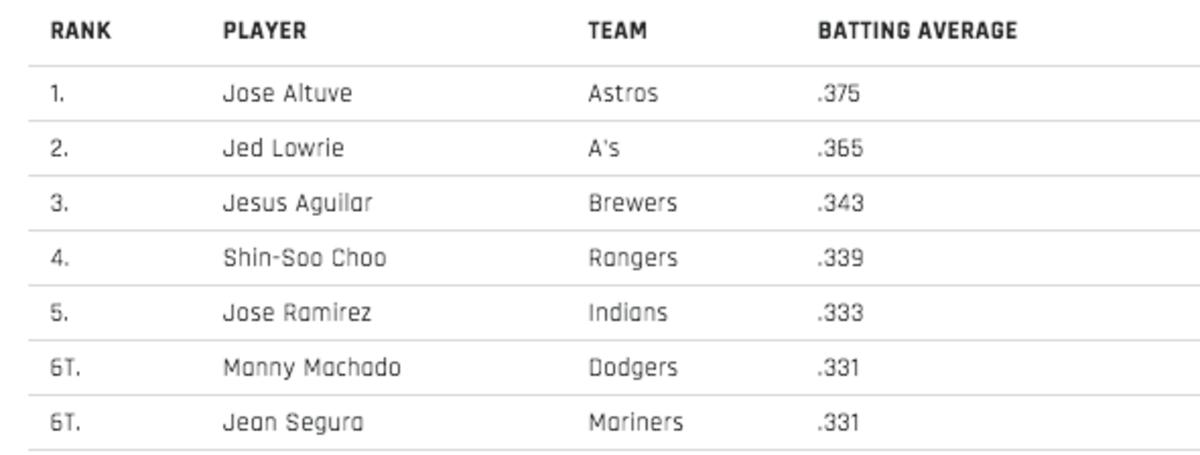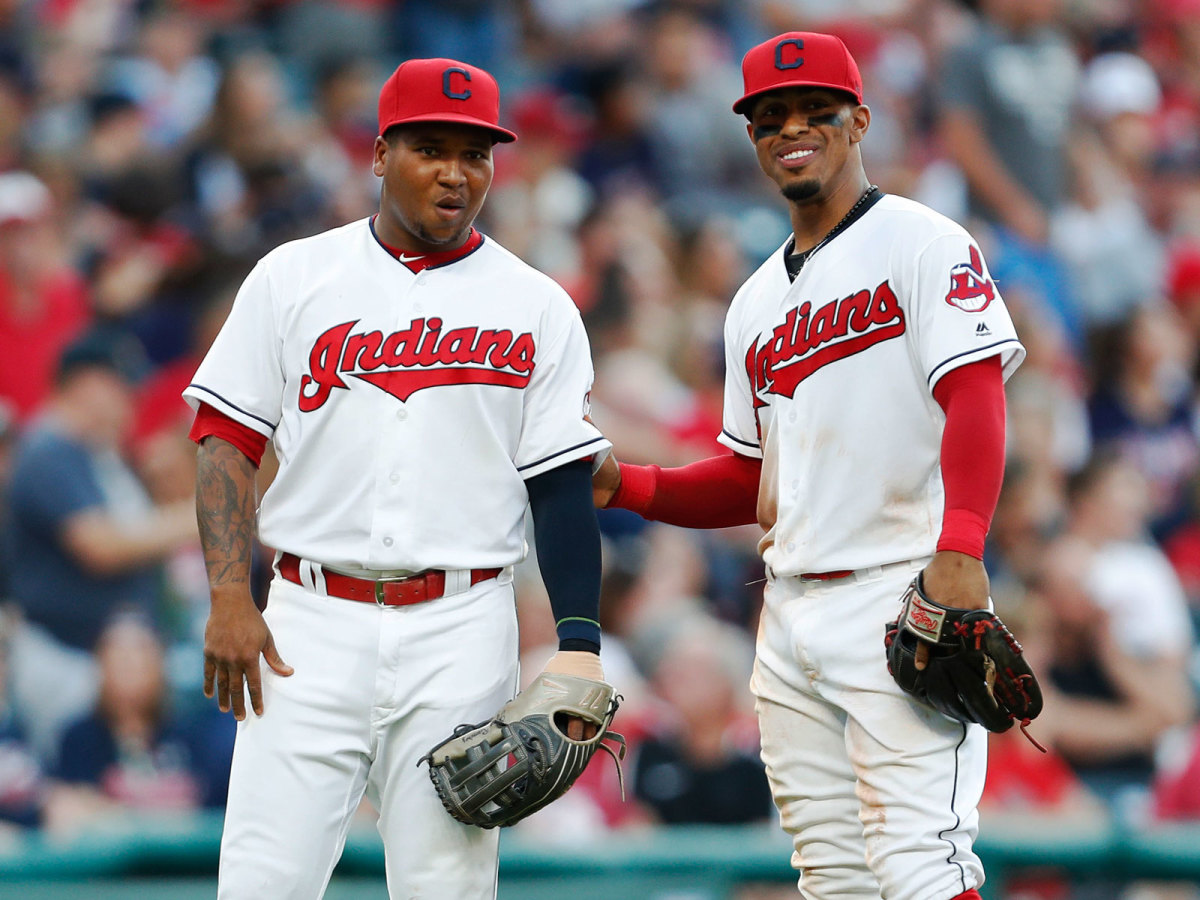The Yankees and Red Sox Are Primed for a Historic Race; More Stretch-Run Storylines

The “halfway” point never has been more of a misnomer in baseball than this year. The season, which started earlier than ever, is 60% over. We’ve entered the sprint phase: a little more than 60 games left for each team. Here are the eight storylines to follow in a second “half” that will go quickly:
1. The race between the Red Sox and Yankees to stay out of the Wild Card Game.
Boston has three fewer losses than New York after playing 101 games. The Red Sox offense has benefited from the wisdom of J.D. Martinez—the professional hitting wonk—and a new philosophy to stop conceding strikes. What was the least aggressive team in baseball is in attack mode. Check out the change in attitude in the batter’s box by Boston batters:
Strikes Taken by Boston Hitters

First Pitch Swings by Boston Hitters
[image:14185128]
But New York, because of its bullpen and schedule, is bound for a big second half to make those final three games in Fenway Park look like a playoff series equivalent.
How terrifyingly good is the Yankees’ bullpen? Their relievers allow only 56% of batters to put the ball in play (770 of 1,371). The New York bullpen in several categories looms as one of the best in the live ball era (rankings since 1920).

As for the schedule, the Yankees and Red Sox play 10 times against one another. It’s likely they go 5–5 in those head-to-head games. And when it comes to the rest of the schedule, New York has a decided edge:

See you in Fenway on the last weekend.
2. Mannywood: The Sequel
By getting Manny Machado, Los Angeles just became the definitive team to beat in the National League. Machado is one of the five best players in the game and—here’s the key, and why the Dodgers moved closer to their first World Series since 1988—he hits good pitching.
As relief pitching has overtaken baseball, I have come to value great hitters as the ones who hit relief pitching. Why? You’re often going to see better stuff, lose the platoon advantage and be less familiar with the pitcher.
Think about this: since the mound was lowered in 1969, the five toughest seasons to get a hit against relievers all have occurred since 2011. This year ranks fifth, at .244. This season also includes the greatest ever strikeout rate by relievers (8.98 per nine innings).
Now look at the guys who hit good pitching:
Best Batting Average vs. Relief Pitching

The Dodgers aren’t a lock to get to the World Series. They’re still looking for a power arm in their bullpen, Clayton Kershaw is a slider-throwing machine to avoid too many of his now-90 mph fastballs, Ross Stripling and that stressful over-the-top delivery is a month away from passing his career high in innings, and Alex Wood has a 4.04 ERA in the past calendar year. But Machado is an impact addition—and that impact just might be greatest in October, when you have to beat good pitching.
3. The Value of Bryce Harper
Bryce Harper’s high-maintenance swing fell apart in the first half of the season. Why? Nationals manager Dave Martinez said, “He wants to win this year more than any other year”—knowing it could be his last year in Washington.
But it’s more than that. It’s the pressure of impending free agency, it’s injuries to Daniel Murphy and Ryan Zimmerman that have thrown a bigger load on him, and it’s the way opposing teams have conspired against him. So here you go: the recipe for hitting .199 over his past 80 games:
1. Harper sees fewer pitches in the strike zone than any hitter in baseball.
2. Teams have doubled the number of shifts he sees.
3. And, frustrated by 1 and 2, he is trying to force power by chasing and pulling pitches and, as I’ve detailed before, dropping more into his legs, which has created even more head movement for a guy who moves his head a lot anyway. The extra movement also has disconnected the timing between his lower and upper half.
You want the diagnostics of a collapse? Here you go* (all stats through the All-Star Break):
Harper Facing Shift

Harper Pulled Groundball Outs

Harper vs. Strikes Away

The good news for Harper is that in the Home Run Derby his swing looked the best it has all year—on time, connected (between the lower and upper half) and with his backside through. Did you happen to note all the balls he hit to dead centerfield?
People paid attention at the Derby to how Harper smiled and appeared more relaxed than he has in months. True. But more importantly, his swing was back in sync. Maybe it was the comfort of seeing his dad, Ron, out there throwing to him, just as he did at the high school field in Las Vegas when Bryce was just a kid.
“He hit my barrel nine times out of 10,” Harper said.
The Nationals have 66 games remaining. If Harper continues to hit around .200, his free agent pay day will take a hit—less years but with a robust average annual value—because teams will question whether that swing will hold up for a decade. (Age is the undefeated enemy of unorthodox swings: Carlos Gomez, Carl Crawford, Carlos Gonzalez, Hunter Pence, et al.) Look at successful hitters in their 30s right now and tell me when you find someone with a violent swing.
But if Harper found the timing of his swing in the Home Run Derby and carries it through the second half—and as Murphy and Zimmerman get healthy and allow him to quit chasing—then Harper will be the $400 million player we thought he might. In a game that pivots on power and age, Harper, at age 25 with a career .510 slugging percentage, and with drawing-card status, offers teams a rare buy on an open market.
4. The unfortunate greatness of Mike Trout (Part VII)
Trout is not going to run down Babe Ruth for the greatest WAR in a season, but he will be an MVP candidate again for another bad Angels team.
Trout has batted more times with the bases empty this year (267) than anybody who doesn’t bat leadoff. He has 25 home runs and, despite hitting .327 with runners in scoring position, only 50 RBI.
And now even the commissioner is knocking Trout for not “marketing” himself. Please. Again: baseball players today need World Series exposure—when the regional strength of baseball becomes national—to be “marketed.” Why does Buster Posey do insurance commercials and Trout does not? It’s not because Trout chooses not to; it’s because Posey has won three World Series.
The Star That Still Won't Shine: The Incredible, Unprecedented but Unseen Greatness of Mike Trout
Trout’s jersey ranked eighth in MLB sales last year—eighth—behind such players as Posey and Yadier Molina.
I recently asked Trout if he ever turned down endorsements. “I have, [but] nothing crazy.”
Would you like to do more?
“If it’s the right fit for me and time-wise, I’ll do it. The biggest thing for me is during the season making sure I have my mind right for baseball. If the time’s right I’ll do it, but you’ve got to make sure you’re mentally and physically prepared to play baseball first.”
Trout has endorsements with Nike, Body Armor and Topps.
“I basically do my endorsement and photo shoots right before spring training—knock it out before the season starts.”
Have you ever been asked to appear on a late night television talk show?
“Um, maybe. I’m not sure off the top of my head. Maybe not.”
Is it easier for you just to avoid these opportunities?
“No. If it’s the right time and it’s not too time-consuming, I’ll do it.”
Trout still hangs with his high school buddies from Millville, N.J. He is building a house close to his parents’ home there. It will have hundreds of acres to fish and hunt with his buddies, a full court for basketball and a complete home gym. “I’ll never have to leave,” he joked. He is not a self-promoter, so don’t ask him to be one.

5. The Historic Tandem in Cleveland
Francisco Lindor and Jose Ramirez are on pace for at least 94 extra base hits. Only one pair of teammates ever had 90 total bases in a season: none other than Babe Ruth and Lou Gehrig of the famed 1927 Yankees.
Cleveland has a cakewalk to the playoffs, thanks to a historically bad division. The Indians are 25–7 against the Tigers, White Sox and Royals—and 29–37 against everybody else.
6. The Ineptitude of the Royals and Orioles
Both teams are playing under .300 baseball. You have to go back to 1939 (Browns and Phillies) to find one year with two teams that were this atrocious. To find two team in the same league this terrible, you have to go all the way back to 1895 (St. Louis Browns and Louisville Colonels of the National League).
7. Awards Watch
The American League Cy Young Award race is the most interesting in years. Chris Sale has the slight edge (leader in ERA and strikeouts), but Justin Verlander (leader in WHIP and innings), Luis Severino (leader in wins; second to Sale in WAR), Gerrit Cole (leader in fewest hits per nine, second in strikeouts), Corey Kluber (leader in strikeout to walk rate and fewest walk rate), Trevor Bauer (second in innings, second in ERA, third in WAR) and Blake Snell (third in ERA) are right there.
Likewise, the NL MVP is a complete toss-up (Lorenzo Cain, Freddie Freeman and Nolan Arenado top a crowded field) and the AL MVP is likely to come down to Trout, Mookie Betts, Lindor, Ramirez, Aaron Judge and Jose Altuve.
Shohei Ohtani and Gleyber Torres duel for the AL Rookie of the Year, while Brian Anderson and Juan Soto lead the NL rookies.
Leaders for Managers of the Year—and postseason berths will decide these—are Alex Cora and A.J. Hinch in the AL, and Gabe Kapler and Brian Snitker in the NL.
8. Drought Watch
It’s been a drought-busting era. Five of the 10 longest championship droughts have ended in the past 14 World Series (2004 Red Sox, 2005 White Sox, 2010 Giants, 2016 Cubs, 2017 Astros). The last two World Series alone ended 162 combined years of waiting.
Who’s got next? Here are some droughts of various shapes and sizes that could be busted this year, ranked in order of likelihood it comes to an end:
Mariners: Longest current postseason drought (16 seasons).
Astros: Longest World Series drought without a repeat winner (17).
Dodgers: Longest franchise championship drought (30).
Indians: Longest current championship drought and fifth-longest ever (69).
Nationals: Longest current pennant drought and second-longest ever (49).
Brewers: Third-longest current championship drought (49).
